
Genetics (A-level biology)

Genetics
This is a branch of biology that tries to explain the cause of similarities and differences between parents and their offsprings. The first quantitative experiments on the hereditary of any significance were carried out in the middle of the nineteenth century by Gregor Mendel on the garden peas
Specific objectives
The learner should be able to
- Explain the concepts of inheritance
- Define genetics terms
- Explain inheritance of trains using the monohybrid and dihybrid crosses.
- Discuss the challenges of inheritable disorders
- Explain gene interaction, sex linkage, sex determination, sex limitation, lethal genes, and polygenes.
Terminologies.
- Agene
This is the basic unit of hereditary and occupies a discrete position on the chromosomes. The gene controls the production of enzymes which in turn determines the process that goes on in a cell and eventually in the organ and the entire organism. In sexually reproducing organisms, genes occur in pairs, where each member of a pair is contributed by the female and male parents.
2. Alleles (Allelomorphs)
This is one of the pair of a gene that occupies the same locus (position). Alleles are genes that are responsible for the production of contrasting characteristics such as tallness and shortness in plants and animals.
3. Genotype
This is the genetic constitution of an organism i.e. the particular set alleles, leading to observable characteristics
4. Phenotype
This is the physical characteristic of an organism determined by the genotype and the environment.
Monohybrid inheritance
This an inheritance that deals with a single pair of contrasting characteristics such as Tallness and shortness when concerned with the height of peas.
In his investigation of a single pair of contrasting characteristics, Mendel observed that in the first filial (F1) generation one of the characters never appeared only to appear in the second filial (F2) generation in small proportion compared to the one that appeared in the first filial (F1) generation.
For example; he crossed peas with long internode, with peas of short internodes. He observed that in the F1 generation, all plants had long internodes. When selfed to produce F2, the peas with short internodes, then appeared in small proportions.
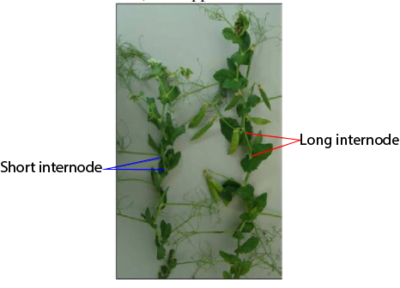

The result of these crosses can be illustrated as follows,

It was concluded from the results that inheritance is a process in which discrete structure or particle (genes) which may or may not show themselves in the outward appearance of the organism are transmitted from parent to offspring.
The evidence of the existence of inheritable particles is got from the observation that they can be combined in one generation but separate in the next, as in witness by the recovery of the short form in F2 generation despite its absence in the F1 generation,
The characteristic that shows in F1 generation (tallness in this case) is described as being dominant and while that which masked F1 generation (shortness) is said to be recessive.
Genes and their transmission
Gene normally occurs in pair each of which is obtained from each parent. The cross of a tall plant and short plant is shown diagrammatically by the two methods below.
The allele for tallness (dominant) character is represented by a capital letter T while the allele for shortness (recessive character) is represented by small letter t. It is assumed that each parent plant contains a pair of identical alleles; TT in case of tall plant and tt in case of the short plant.
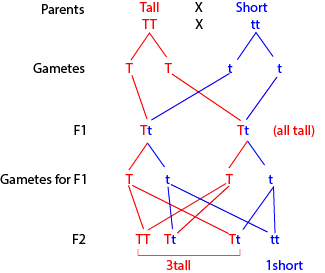
Pannet square to show fusion of F1 gametes
½ T |
½ t | |
| ½ T | ¼ TT | ¼ Tt |
| ½ t | ¼ Tt | ¼ tt |
In terms of probability, there are 3 chances out of four for a tall plant to appear in F2 generation; and one chance of four for a short plant to appear.
Mendel’s laws of inheritance
Mendel’s first law of segregation states that an organism’s characteristics are controlled by two genes (alleles) but only one of them can be carried by in a gamete.
Mendel’s second law of Independent Assortment:
During the formation of gametes, alleles in a pair may combine with another allele from another pair randomly.
Breeding True
Phenotypically TT and Tt are the same i.e. Tall. When an organism contains identical alleles like TT and tt is said to be homozygous and with dissimilar allele is heterozygous.
Since the homozygous (TT) and heterozygous (Tt) peas are both tall there is no way we can distinguish between the two genotypes from their external appearance.
One way of establishing whether a given tall plant is homozygous or heterozygous is to self-pollinate it. If the resultant offsprings are all tall, we can conclude that the parent has the genotype TT.
If, however, we get a mixture of Tall and short plants; the parent plant must have the genotype Tt
The point is that when an organism that is homozygous at a particular locus is self- fertilized it produce offspring all of which are identical with parent. Exactly the same results occur if the organism is crossed with another organism that is homozygous is said to breed true, The organism is said to belong to a pure line for the characteristics in question.
Test crosses
This is the crossing of an individual having homozygous recessive genotype with an individual showing a dormant trait to determine whether that individual is homozygous or heterozygous for the trait.
The homozygous individual produces all offspring having dominant traits while a heterozygous individual produces a mixture of offspring with dominant and recessive traits.
Back cross
This is a cross between hybrids in F1 generation with one of the parents or an organism genetically equivalent to the parents. Backcrossing is mainly aimed at increasing the genetic contribution of one particular parent to the offspring.
Examples Monohybrid inheritance human
A number of human conditions are known to be associated with a single pair of alleles which are inherited in Mendelian fashion.
- Albinism

This is a condition in human beings where the individual fails to produce skin pigments called melanin.
Albinos have;
- Light skin
- White hair
- Pink eyes
- They are sensitive to bright light
The allele for albinism is caused by recessive [a] and so only exerts its effect in the homozygous state [aa]. The allele for melanin production [A] is dominant.
Suppose a couple each with normal pigmentation have an albino child. For this to happen the child must have [aa]. Therefore, unless for rare mutation, the parents must both heterozygous [Aa] so each produces A and a gametes in about equal number. Therefore, randomly to produce three types of genotypes AA, Aa, aa.

2. Congenital diseases such as cystic fibrosis in which the connective tissue develops in glands of the body.
3. Chondrodystrophic dwarfs are characterized by shortened and deformed legs and arms. It is caused by a dominant gene and hence affect in the homozygous and heterozygous state
CO-DOMINANCE
This is a condition where genes determining a particular character all show up such that the phenotype of the offspring is a mixture of that of the parents. It mainly occurs in animals.
Co-dominance is wherein the heterozygous state neither allele is completely dominant over the other i.e. the 2 alleles are co-dominant. This results in the phenotype intermediate between the parent’s appearances. The alleles for each trait are represented with different capital letters.
Example
In animals, the genes for fur color are co-dominant. What will be the offsprings when a red bull is crossed with a white cow?
Solution:
Let R represent the allele for red bull
Let W represent the allele for white cow
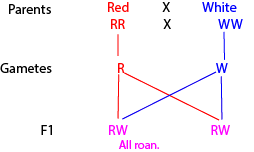
F1 phenotype: all the offsprings will be roan.
What would be the offsprings in the 2nd generation?
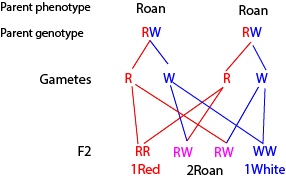
F2 phenotype: 1 red, 2 roan, and 1 white.
INCOMPLETE DOMINANCE
This is a condition in the heterozygous where neither of the alleles is dominant over the other and the phenotype of the offspring is an intermediate between that of the parents. It mainly occurs in plants.
For example, consider petal color in flowers: when a red-flowered plant is crossed with a white-flowered plant, the offspring produced are all pink-colored petal flowers.
Example:
Let R represent the allele for red petal colour.
Let W represent the allele for white flowers
Then Selfing F1 (Cross between offspring in F1)
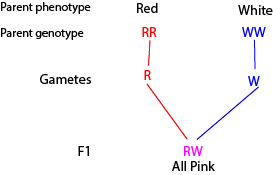
.
F2 Phenotypic ratio: 1 red: 2 pink: 1 white. (1:2:1)

Dihybrid inheritance
This is the inheritance of 2 pairs of characteristics. It’s characterized by a phenomenon called independent assortment i.e. each of the alleles of one gene may combine independently with each of the alleles of another gene.
For instance, when a pure breed tall pea plant possessing purple flowers was crossed with a short plant possessing white flowers and the F1 generation plants were tall and had purple flowers.
These were self-pollinated, in F2 generation there were four different phenotypes observed; tall plants with purple flowers, tall plants with white flowers, short plants with purple flowers, and short plant with white flowers.

EXCEPTIONS TO MENDELIAN INHERITANCE
The following do not conform to the process of inheritance as illustrated by Mendel.
- Linkage
- Incomplete dominance.
- Co-dominance
- Multiple alleles.
Epistasis
This a condition where one gene on a different chromosome interacts or modifies or masks the action of another gene.
Example;
- Gene T on chromosome 9 of gives a pigment that is brown and gene C on chromosome 7 gives the same pigment but when gene T and C are both present they give another pigment purple.
Assuming that Brown dominant to purple what would be the phenotypic ratio of the offsprings.
A – B purple 9
A – bb brown 3 Phenotypic ratio: 9: 6: 1
aa-B brown 3
aabb colorless 1
2. Gene T on chromosome 2 given eyeless drosophila whereas gene C on chromosome 4 gives a brown eyed drosophila. What would be the phenotypic.
A-B eyeless 9
A-bb eyeless 3
aa-B Brown 3
aa-bb colorless or white- 1
Eyeless brown another color
12 :3 :1
3. Dominant complementary genes
This is where gene T and C are necessary for the color to be expressed.
A-B 9 colored
A-bb 3 colorless
aa-B 3 colorless
aabb- 1coluorless
Ratio colored 9:
colorless; 7
4. Recessive complementary gene; is where the recessive alleles must be together before pigment is formed
Ratio 15: 1
5. Gene G in a mouse gives a grey coat while gene B in mice gives a black coat. But when both genes occur G is epistatic to B find the phenotypic ratio.
G-B 9 grey
G-bb 3grey
Ggbb 1 any other time
Ratio Grey 12
black 3 colorless 1
6. In man
Sex-linked are more common in male than female because
(i) Males have only 1 X chromosome, from their mother. If that X chromosome has the gene for red-green color blindness (instead of a normal X chromosome), they will have red-green color blindness.
(ii) Females have 2 X chromosomes, one from their mother and one from their father. To have red-green color blindness, both X chromosomes would need to have the gene for red-green color blindness
ize a gene C is necessary for coloration of the grain while gene P gives purple color to the grain and its recessive gives a red color. Find the phenotypic ratio
C-P 9 purple Phenotypic ratio
C-pp 3 red purple : red :colorless
Cc-P 3colourless 9 : 4 : 3
ccpp 1 red .
Gene linkage & chromosomes
Gene linkage is the existence of many genes as a unit and not as separate individuals. Linked gene occur on the same chromosome and will always segregate together during meiosis and gamete formation.
Dihybrid inheritance and linked genes
In Drosophila melanogaster [fruit fly] Broad body B is dominant to narrow body [b] and normal-sized wing A is dominant to vestigial wing a.
When homozygous dominant drosophila for the 2 characters was crossed with a homozygous recessive for the two characters above mentioned, all the F1 generate drosophila were grey bodied with normal wings.
When two of F1 generation flies were mated the F2 generation failed to yield a 9: 3: 3: 1 ratio we expected. Instead, about ¾ of the offsprings had long wings and broad body and nearly the remaining flies about ¼ of the total had vestigial with and narrow body.

The explanation is that the gene determining the length of the wings and the width of the abdomen are located on the same chromosome. This results in their being transmitted together. Such gene are said to be linked and the general phenomenon is known as gene linkage
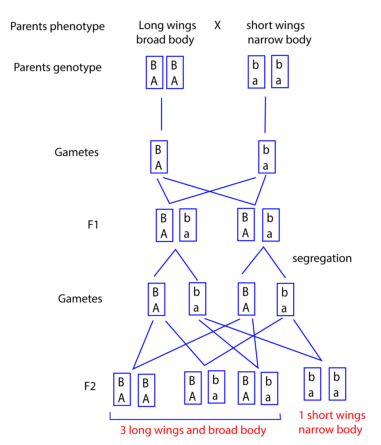
Sex determination.
The medium size chromosome in drosophila melanogaster determines the individual’s sex for which reason they are called the sex chromosome. In the female, the two sex-chromosome, both rod-shaped in appearance, are identical and are known as X-chromosomes. In the male, however, the two sex-chromosome differ from each other one is a rod-shaped X-chromosome, the other is a hook-shaped, and is called Y-chromosome.
The sex chromosomes are the exception to the rule that homologous chromosomes are identical in appearance. Being different they are described as heterosomes; All the other chromosomes, which are identical in appearance, are called autosomes.
Despite this difference, the sex chromosomes are transmitted in a normal mendelian manner as shown below.
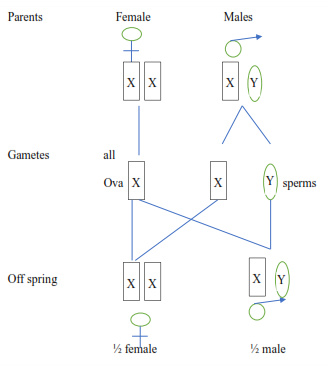
Generally, a female produces only one kind of gamete as the chromosomes are concerned; all her eggs contain an X chromosome. For this reason, inhuman and many other species, the female is said to be homogametic (same gametes). A male on the other produces two kinds of gametes as far as chromosome are concerned: half of the sperm contains a Y chromosome, the other half an X. The male is therefore heterogametic (different gametes) on fusing randomly, approximately half the zygotes receive two X chromosomes and develop into the female, the rest receive Y chromosomes and give rise to males. In some insects, females are XX and male XO
Sex linkage
Sex-linked characters are those whose genes that are carried on sex chromosomes usually X-chromosomes and is inherited along with sex for examples:
(a) red-green color blindness the decreased ability to see color or differences in color. Simple tasks such as selecting ripe fruit, choosing clothes, and reading traffic lights can be more challenging. People with total color blindness (achromatopsia) may also have decreased visual acuity and be uncomfortable in bright environments.
(b) hemophilia
symptoms of hemophilia are
- Unexplained and excessive bleeding from cuts or injuries, or after surgery or dental work
- Many large or deep bruises
- Unusual bleeding after vaccinations
- Pain, swelling or tightness in your joints
- Blood in your urine or stool
(c) eye color in drosophila
Transmission
Hemophilia can be represented as follow
(i) A female hemophilic and normal man
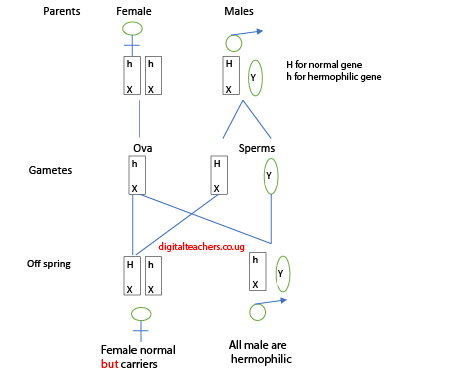
(ii) Female normal X male hemophilic
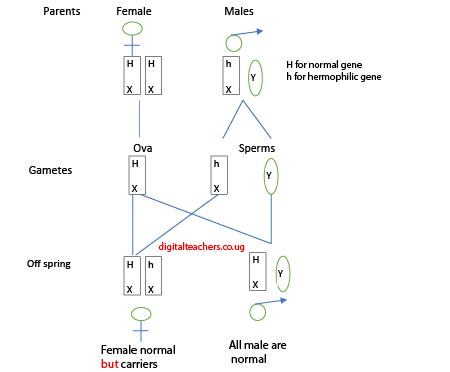
Y-CHROMOSOME.
1. If a sex-linked trait is associated exclusively with Y-chromosome, it is expected to show up exclusively in males. In general, most Y-chromosome are empty. However, the ‘porcupine’ man is said to have transmitted hard and spine skin exclusively to his male children.
2. The hair pinna or ear is a characteristic common in India and it is transmitted to male offsprings only.
Sex-linked are more common in males than females because
(i) Males have only 1 X chromosome, from their mother. If that X chromosome has the gene for red-green color blindness (instead of a normal X chromosome), they will have red-green color blindness.
(ii) Females have 2 X chromosomes, one from their mother and one from their father. To have red-green color blindness, both X chromosomes would need to have the gene for red-green color blindness
Sex limited characters
These are characters that that show up exclusively in one sex only e.g. ovary in female
Note: A sex-limited character is one that is controlled by a gene located on any chromosome but expresses itself in only one of the two sexes.
Crossing over.
In maize, smooth kennels are dominant to shrunken ones and colored kennels are dominant to colorless. The gene for texture and color are linked. When a maize plant homozygous for a kennel which are Smooth and colored is crossed with that with shrunken and colorless kennels; F1 generation yields all colored smooth kennel. However, F2 generation contains small proportions of maize with smooth and colorless or colored and shrunken kennels as opposed to what is expected,
These small proportions are explained by cross over; During prophase 1in meiosis, homologous chromosomes become intertwined and at chiasmata chromatids break and rejoin. The result is that portions of the chromatids belonging to the two homologous chromosomes change places taking their alleles with them, So the chiasmata result in crossing over.


Multiple alleles
Multiple alleles are two or more alternative forms of a gene controlling a particular characteristic, of which any two may occupy the same gene loci on homologous chromosomes.
An example of such multiple alleles is provided by the alleles controlling the ABO blood group system in humans. The ABO system is controlled by three alleles generally referred to as IA, IB, and IO.
The IA allele is responsible for the production of type A antigens in the person’s red blood cells, and the IB allele for type B antigen. The I0 produces neither antigen.
But only two of the three alleles can be present at any one time, an individual may thus, possess any of the following six genotypes; IAIA, IAI0, IBIB, IBIO, IAIB, and IOIO.
IA and IB show equal dominance with respect to one another [i.e. they are codominant] but each is dominant to IO thus;
- A person belongs to blood group A has genotype IAIA or IAI0
- A person belongs to blood group B has genotype IBIB or IBIO
- A person belongs to blood group AB has genotype IAIB
- A person belongs to blood group O has genotype IOIO
The fact that there more than two alleles responsible for determining the blood group makes no difference to their transmission, which takes place in a normal Mendelian fashion.
Thus, a child whose parents are both blood group O must be group O. However, a parent with blood A or B, the child may have any of the blood groups has shown below.

Lethal alleles
The color inheritance in mice.
Yellow furs are dominant to grey. If a pair of yellow mice are mated, the results are always the same i.e. 2/3 of offsprings being yellow and 1/3 grey.
They occur in a ratio of 2: 1 instead of 3: 1 because homozygous individuals for yellow die off before birth. i.e. genotype YY presents a lethal combination of genes.
This has to been confirmed
(i) the present or dead embryo in the uterus
(ii) the yellow mice do not breed true i.e., crossing yellow mice with yellow mice does not produce exclusively yellow mice.
For question and answers download PDF
Please find free downloadable notes, exams and marking guides of agriculture, biology, Physics, chemistry etc. from digitalteachers.co.ug website.
Dr. Bbosa Science

well explained notes
Thanks for it Doctor
Very good work
Great experience for it
I am so grateful for your blog post.Much thanks again. Want more.
I love how informative and concise this is. Toys & Games
This is a must-read for everyone. Thanks! Real Madrid News
Explore outstanding opportunities at the Top MBBS Colleges in Orissa, known for academic excellence.
Win exciting rewards and enjoy seamless gaming on Raja Luck.
Sign up with the neighborhood of eager gamers at 82 Lottery and test your luck today.